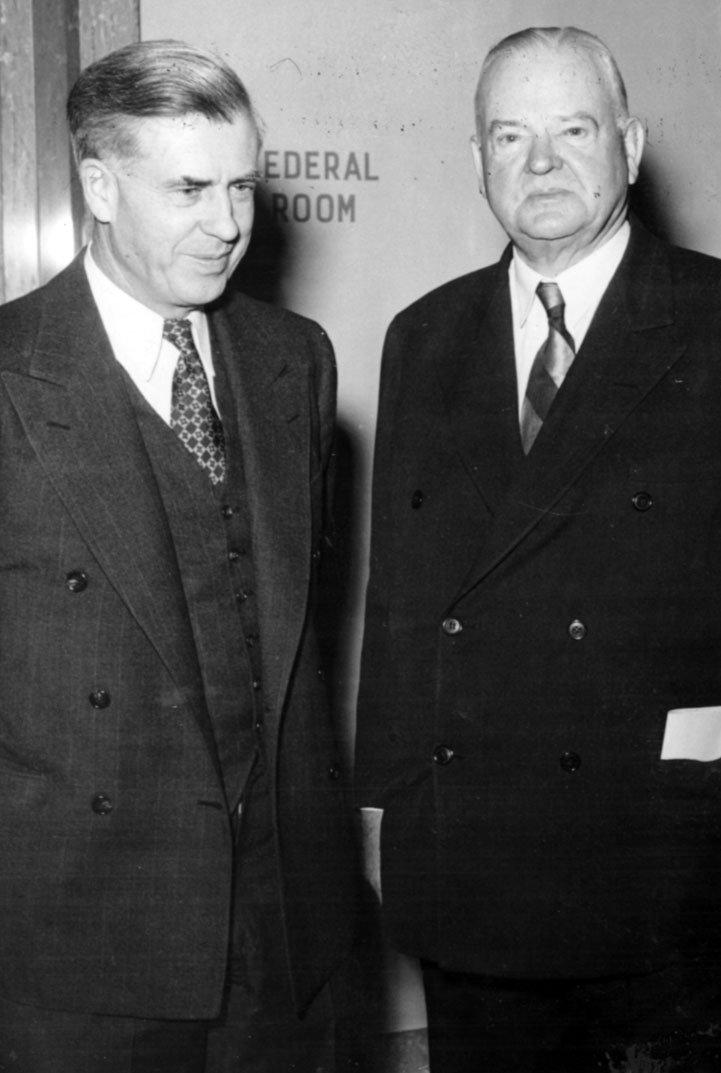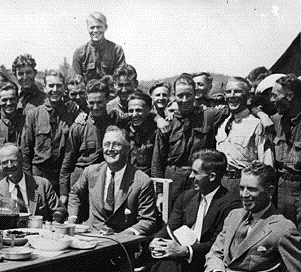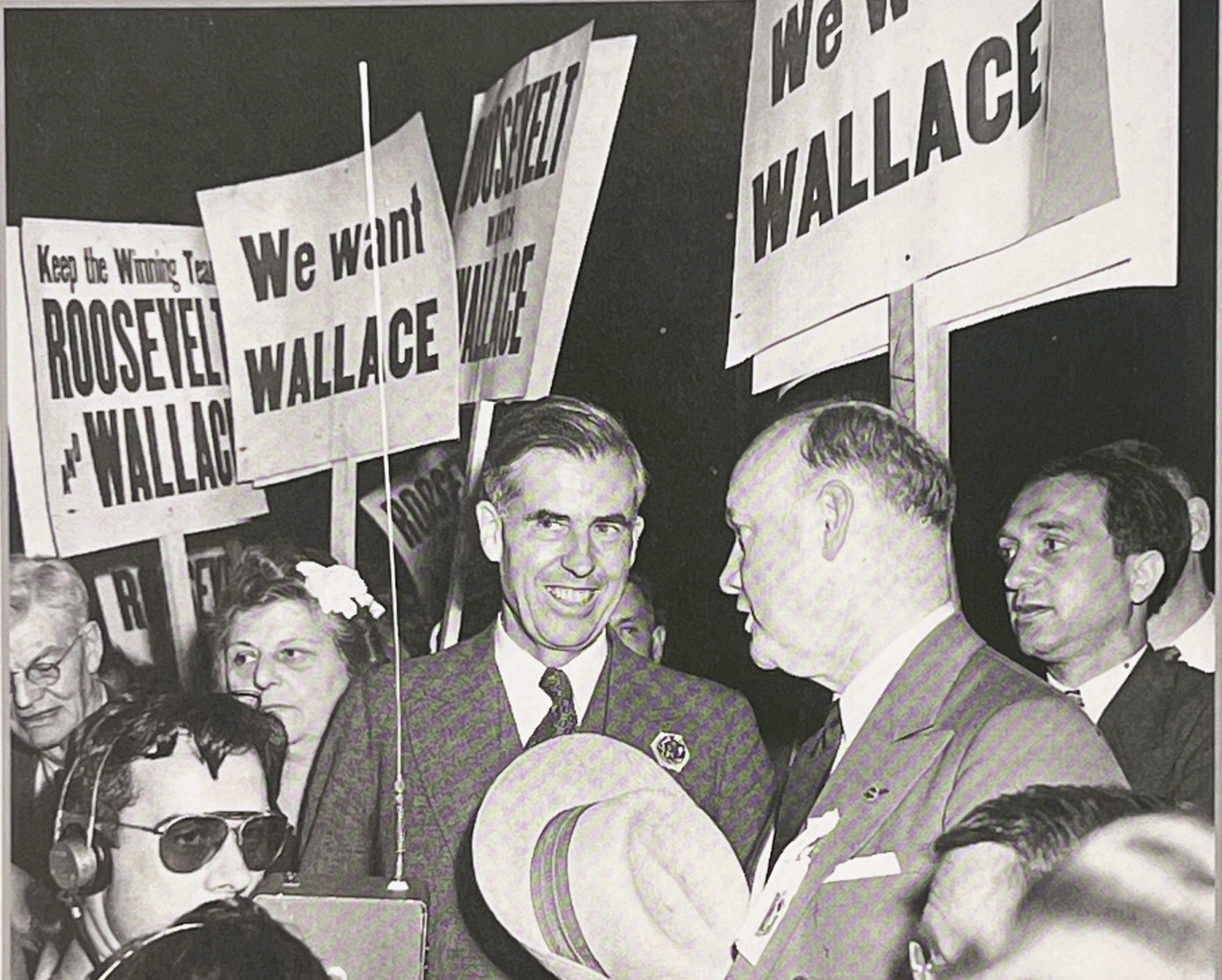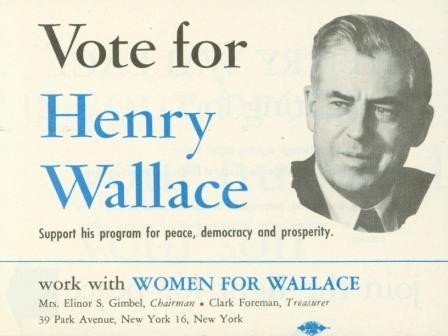
Timeline

1888
Wallace is born into an agricultural family near rural Orient, Iowa.
1895
Young Wallace is tutored in botany on walks after school with George Washington Carver, the genius plant geneticist, born a slave, who was a student and friend of Wallace's father at Iowa State, and went on to head the Agriculture Department at Booker T. Washington's Tuskegee Institute.
1898
Wallace's grandfather "Uncle Henry" Wallace establishes "Wallace's Farmer," which became the leading farm journal in America.
Wallace, father Henry C, grandfather Henry, and infant son Henry B
1904
15-year-old Wallace researches and disproves the universally accepted theory that the most attractive corn ears produced the highest yield. "What's looks to a hog?" he asked.
1910
Wallace becomes a staff writer for Wallace's Farmer after graduating Iowa State, becoming co-editor with his father after his grandfather dies in 1916.
1914
Wallace marries Ilo Browne of Indianola, Iowa, and they have three children, sons Robert and Henry and daughter Jean.
1921
Wallace becomes editor of Wallace's Farmer and a leading voice for American agriculture, after his father moves to Washington DC to become US Secretary of Agriculture under Republican President Warren Harding.
1926
Wallace creates Pioneer Hi-Bred Corn, the first company to commercialize hybrid corn for increased yields, with a $5000 investment from his wife's dowry. It is sold three-quarters of a century later to the Dupont Corporation for about $10 billion.
1928
Wallace, a lifelong Republican, endorses Democrat Al Smith for President, because he supports farm relief, and Wallace's belief that opponent Herbert Hoover, as Secretary of Commerce siding with corporations against small farmers, had essentially caused his father's premature stress-induced death.
Wallace as Vice President with former President Herbert Hoover
1932
Wallace advises FDR on solutions to the farm crisis and Dust Bowl, and campaigns heavily for him.
Wallace and Labor Secretary Frances Perkins.
1933
Wallace is appointed FDR's Secretary of Agriculture, where he runs massive programs to restore farm income, institute soil conservation, school lunches and food stamps, helps Labor Secretary Frances Perkins create Social Security, and helps design the Civilian Conservation Corps. Historian Arthur Schlesinger later calls him "the best secretary of agriculture the country has ever had."
FDR, Wallace, and Civilian Conservation Corps workers.
1936
Wallace switches to the Democratic Party.
1940
As WW2 looms, the Democratic convention accepts FDR's insistence that he will not run for a third term unless Wallace is his running mate, at the urging of Eleanor Roosevelt, in her famous "No Ordinary Time" speech. They win in a landslide.
Campaign pin for Henry Wallace’s Vice Presidential Campaign in 1940.
Cover of Newsweek from November 11, 1940.
1941
Wallace travels to Mexico as FDR's goodwill ambassador, urges the establishment of an agricultural station in Mexico headed by young Iowa agronomist Norman Borlaug, which ultimately leads to vast increases in corn and wheat crop yields around the world in the "Green Revolution," saving some two billion from starvation and earning Borlaug the 1970 Nobel Peace Prize.
Wallace and Borlaug.
1942
Wallace delivers his famous "Century of the Common Man" speech, countering conservatives' calls for American and British domination of the world after the war. The speech inspires composer Aaron Copland to write his iconic anthem "Fanfare for the Common Man."
“The century which we are entering can be and must be the century of the common man.”
—Henry Wallace Speech, 8 May 1942, in 'Vital Speeches' (1942) vol. 8, p. 483
1944
Despite Gallup polling showing Wallace the overwhelming favorite to stay on the ticket as Vice President in 1944, and Truman polling only at 2 percent, Wallace is replaced by Harry Truman as the vice presidential nominee at the Democratic Convention, at the insistence of party bosses.
1945
FDR is reelected to a fourth term, with Truman as VP. Wallace is confirmed to serve as FDR's Secretary of Commerce. FDR dies.
Inauguration day 1945.
Wallace swearing in his successor as VP.
Wallace signing the Secretary of Commerce oath administered by Justice Hugo Black.
1946
Wallace is fired as Secretary of Commerce by President Truman, citing a Wallace foreign policy speech which Truman admitted he had read closely "page by page" and approved in advance, but which proved embarrassing when Secretary of State Byrnes criticized it.
Byrnes, Truman & Wallace at FDR's funeral.
1947
Wallace serves as editor of the magazine The New Republic.
1948
Wallace runs for President as the candidate of the new Progressive Party, against Democrat Truman, Republican Thomas Dewey, and segregationist Strom Thurmond, and garners just over one million votes.
Wallace campaigning with folk singer Pete Seeger.
Campaign pin for Henry Wallace’s Presidential Campaign in 1948.
Promotional material for Henry Wallace’s Presidential Campaign in 1948.
1949
Wallace and his wife Ilo retire to a farm near Hyde Park NY, where he resumes agricultural research, on subjects like chickens, strawberries, and gladiolas.
1959
With wealth generated by Pioneer Hi-Bred International, Wallace endows a foundation, the Wallace Genetic Foundation, which is subsequently split into three separate foundations by his children in 1995: the Wallace Global Fund, Wallace Research Foundation, and Wallace Genetic.
1965
Wallace dies of Amyotrophic Lateral Sclerosis ("Lou Gehrig's Disease"). A fighter to the end, he meticulously documents the shutting down of his body, for researchers at NIH, until he can write no more.




























